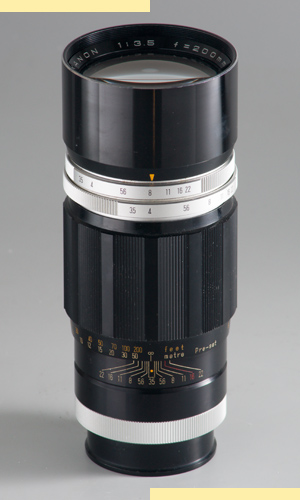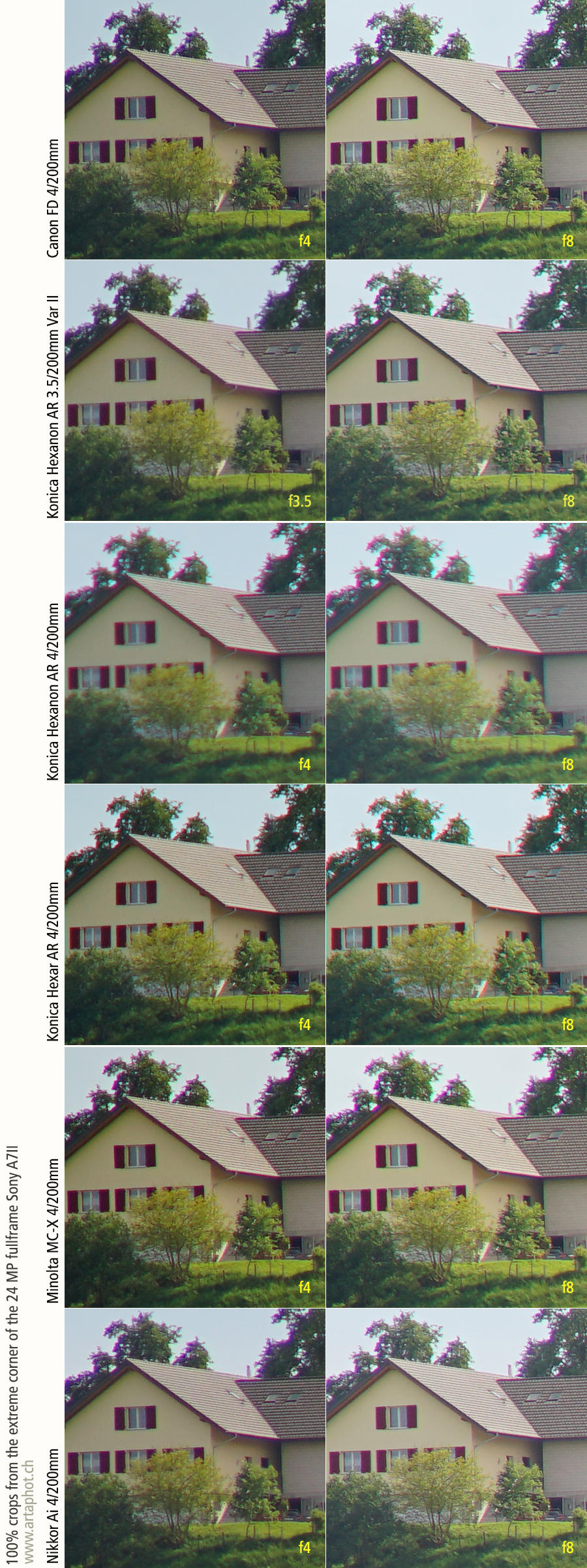There are two different optical constructions of the Konica Hexanon AR 3.5/200 mm. The first, a [5/5] design, looks like a Ernostar / Xenotar hybrid; the second one is more Sonnar-like. Both lenses are large and heavy (830 g and 860 g, respectively).
The first computation originally came with the earlier (and smaller) bayonet for F-mount SLRs such as the Konica F, the Konica FS, the FP, and the FM. Later on, it was built with the AR bayonet as well.
The second computation is said to be an excellent performer, and Konica itself was emphasizing its outstanding detail resolution. However, if we compare the lens with other 4/200 mm lenses from around 1975-1980, it's obvious that corresponding Canon, Minolta and Nikon lenses may have been even slightly sharper, at least at infinity. That said, the AR 3.5/200mm (II) has pretty well controlled lateral CAs; in its time (late 1960s) it certainly was a very good design. Only the very best 200mm lenses from the 1970s and the 1980s such as the Leitz Apo Telyt 3.4/180mm, the Nikkor 2.8/180mm ED (1981) or the Minolta AF 2.8/200mm APO (1988) can clearly outperform the AR 3.5/200mm.
As others have mentioned before, the AR 3.5/200mm outperforms the later Hexanon AR 4/200mm: it has sharper corners and less lateral CAs than the later AR 4/200mm. However, the cheaper Hexar AR 4/200mm (a huge [4/4] design) surprisingly performs as well as the Hexanon AR 3.5/200mm.
All these lenses are well built, and their aperture ring is easier to handle as with most Konica AR prime lenses. Focusing however is quite stiff; this is a typical property of most Konica AR primes with rubber focusing grip.
Das Hexanon 3.5/200m wurde in zwei deutlich unterschiedlichen optischen Rechnungen gefertigt. Die erste Rechnung, die um 1960 zusammen mit der legendären und seltenen Konica F auf den Markt kam, könnte als Ernostar-Xenar-Hybrid bezeichnet werden. Die zweite Rechnung hingegen ist dem Sonnar-Typus zuzuordnen.
Das ursprünglich für die Konica F gefertigte Hexanon 3.5/200mm hatte noch eine Vorwahlblende. Dieselbe optische Konstruktion findet sich auch in frühen 3.5/200mm Hexanonen mit dem AR-Bajonett − auch hier zunächst noch ohne Springblende (siehe Abbildung unten).
Recht bald nach Erscheinen der Konica "Autoreflex" (1965), deren Belichtungsautomatik auf eine Springblende angewiesen war, erfolgte eine Überarbeitung der optischen Konstruktion und der Fassung. Dieses neue, auf dem Sonnar basierende AR 3.5/200mm nun voll kompatibel mit der Blendenautomatik der Autoreflex-Serie. Das Hexanon AR 3.5/200mm [5/4], also die neuere Rechnung, galt damals als exzellentes Teleobjektiv, und Konica betonte in den hauseigenen Werbeschriften ausdrücklich die hohe Auflöung dieser Konstruktion. In der Tat kann die zweite Version des Hexanon AR 3.5/200mm an 24 MP Vollformat gut mit den später gerechneten 4/200mm Objektiven der Konkurrenz mithalten. Ende der 1960er Jahre war es mit Sicherheit deutlich besser als das damalige (berühmte!) Nikkor-Q Auto 4/200mm. Diese zweite vom Sonnar abgeleitete Rechnung des AR 3.5/200mm findet sich sowohl in der klassischen Fassung mit Metall-Fokusring als auch in der späteren Fassung mit Gummiwaffel-Fokusring.
 |
 |
KONICA HEXANON 200mm 1:3.5 erste Variante |
 |
 |
KONICA HEXANON 200mm 1:3.5 zweite Variante |
Test results of the three later Konica 200mm lenses (Hexanon AR 3.5/200mm, Hexanon AR 4/200mm, Hexar AR 4/200mm), compared to the Canon FD 4/200mm, the Minolta MC-X 4/200mm and the Nikkor Ai 4/200mm:


